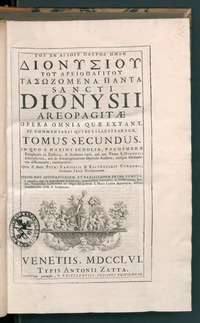Dionysius the Areopagite
Dionysius the Areopagite (/ˌdaɪəˈnɪsiəs/; Greek: Διονύσιος ὁ Ἀρεοπαγίτης Dionysios ho Areopagitês) was a judge at the Areopagus Court in Athens, who lived in the first century. A convert to Christianity, he is venerated as a saint by multiple denominations.
Saint Dionysius the Areopagite | |
|---|---|
 Depiction of St. Dionysius from the illuminated Menologion of Basil II, c. 1000 AD. | |
| Hieromartyr and Bishop of Athens | |
| Born | c. 1st century AD |
| Died | c. 1st century AD |
| Venerated in | Catholicism Eastern Orthodoxy Armenian Orthodoxy |
| Feast | 3 October (EO), 9 October (RC) |
| Attributes | Vested as a bishop, holding a Gospel Book |
| Patronage | Athens, Crotone, Jerez de la Frontera and Ojén |

_-_Dionysius_Areopagite.jpg)
Life
As related in the Acts of the Apostles (Acts 17:34), he was converted to Christianity by the preaching of Paul the Apostle during the Areopagus sermon, according to Dionysius, Bishop of Corinth, as quoted by Eusebius. He was one of the first Athenians to believe in Christ.
Tradition holds that earlier, at a young age, he found himself in Heliopolis of Egypt (near Cairo) just at the time of Christ's crucifixion in Jerusalem. On that Great Friday, at the time of the crucifixion of Christ, according to the gospel, "From noon until three in the afternoon darkness came over all the land." (Matthew 27:45). The young boy, Dionysius was shocked by this paradoxical phenomenon and exclaimed: "God suffers or is always despondent" ("God suffers or is lost all"). He took care to note the day and hour of this supernatural event of the darkness of the Sun.
When Dionysius returned to Athens, he heard the preaching of the Apostle Paul in the Areopagus Hill in Athens, talking about that supernatural darkness during the Crucifixion of the Lord, dissolving any doubt about the validity of his new faith. He was baptized, with his family in 52 AD. The acceptance of Dionysius of Christ refers to the Acts of the Apostles in chapter 17 and verse 34 "The men who have been sealed have believed in them, and Dionysius the Areopagite, and the name of Damaris, and the others in it." Thus, when Dionysius heard Paul preach on Christ on the Areopagus Hill in Athens, he recalled this experience which reinforced his conviction that Paul was speaking the truth on Christ as the long-promised Messiah and Savior of the World. Historical accounts wrote that when he learned that the Mother of Christ, Mary, lived in Jerusalem, he travelled to Jerusalem to meet her. From this meeting he said: "Her appearance, her features, her whole appearance testify that she is indeed Mother of God." In Jerusalem, he also discovered where Mary slept and departed this world to join her Son and her God. Then he wept sorely like the Apostles and other Church leaders torrents of tears and also attended Mary's funeral in Jerusalem. Dionysius suffered a Christian martyr's end by burning. His story was preserved by the early Christian historian, Eusebius of Caesarea in his Ecclesiastical history
After his conversion, Dionysius became the first Bishop of Athens.[1] He is venerated as a saint in the Catholic and the Eastern Orthodox churches. He is the patron saint of Athens and is venerated as the protector of the Judges and the Judiciary. His memory is celebrated on October 3. His name day in the Eastern Orthodox Church is October 3[2] and in the Catholic Church is October 9.[3]
In Athens there are two large churches bearing its name, one in Kolonaki on Skoufa Street, while the other is the Catholic Metropolis of Athens, on Panepistimiou Street. Its name also bears the pedestrian walkway around the Acropolis, which passes through the rock of the Areios Pagos.
Dionysius is the patron saint of the Gargaliani of Messenia, as well as in the village of Dionysi in the south of the prefecture of Heraklion. The village was named after him and is the only village of Crete with a church in honor of Saint Dionysios Areopagitis.
Historic confusions
In the early sixth century, a series of writings of a mystical nature, employing Neoplatonic language to elucidate Christian theological and mystical ideas, was ascribed to the Areopagite.[4] They have long been recognized as pseudepigrapha, and their author is now called "Pseudo-Dionysius the Areopagite".
Dionysius has been misidentified with the martyr of Gaul, Dionysius, the first Bishop of Paris, Denis. However, this mistake by a ninth century writer is ignored and each saint is commemorated on his respective day.[5]
See also
- St. Dionysus Institute in Paris
- Early centers of Christianity#Greece
- Cathedral Basilica of St. Dionysius the Areopagite (A Roman Catholic church in Athens named after Dionysius the Aeropagite)
References
- Eusebius, Historia Ecclesiae III: iv
- "Dionysios the Areopagite - Greek Orthodox Archdiocese of America". www.goarch.org. Retrieved 2018-10-04.
- Online, Catholic. "St. Dionysius the Areopagite - Saints & Angels - Catholic Online". Catholic Online. Retrieved 2018-10-04.
- Stanford Encyclopedia of Philosophy on the confusion between Dionysius and Pseudo-Dionysius
- "Hieromartyr Dionysius of Paris, Bishop". oca.org. Retrieved 2015-10-16.
Sources
- Corrigan, Kevin; Harrington, Michael. "Pseudo-Dionysius the Areopagite". In Zalta, Edward N. (ed.). Stanford Encyclopedia of Philosophy.
External links

- Hieromartyr Dionysius the Areopagite the Bishop of Athens Orthodox icon and synaxarion
- Max Müller Dionysius the Areopagite Lecture 1895
| Catholic Church titles | ||
|---|---|---|
| Preceded by New Creation or Hierotheos |
Bishop of Athens 125 - 129 |
Succeeded by Publius |